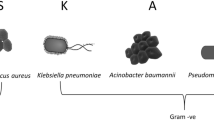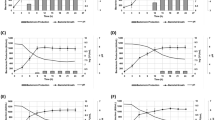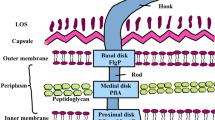Abstract
As Klebsiella pneumoniae (KP) has acquired high levels of resistance to multiple antibiotics, it is considered a worldwide pathogen of concern, and substitutes for traditional antibiotics are urgently needed. 3-Phenyllactic acid (PLA) has been reported to have antimicrobial activity against food-borne bacteria. However, there was no experiment evidence for the exact antibacterial effect and mechanism of PLA kills pathogenic KP. In this study, the Oxford cup method indicated that PLA is effective to KP with a minimum inhibitory concentration of 2.5 mg/mL. Furthermore, PLA inhibited the growth and biofilm formation of in a time- and concentration-dependent manner. In vivo, PLA could significantly increase the survival rate of infected mice and reduce the pathological tissue damage. The antibacterial mode of PLA against KP was further explored. Firstly, scanning electron microscopy illustrated the disruption of cellular ultrastructure caused by PLA. Secondly, measurement of leaked alkaline phosphatase demonstrated that PLA disrupted the cell wall integrity of KP and flow cytometry analysis with propidium iodide staining suggested that PLA damaged the cell membrane integrity. Finally, the results of fluorescence spectroscopy and agarose gel electrophoresis demonstrated that PLA bound to genomic DNA and initiated its degradation. The anti-KP mode of action of PLA was attributed to the destruction of the cell wall, membrane, and genomic DNA binding. These findings suggest that PLA has great potential applications as antibiotic substitutes in feed additives against KP infection in animals.









Similar content being viewed by others
Data availability
All data analyzed during this study are included in this published article. The raw data of this study are available from the author Gaowei Hu upon reasonable request.
References
Hu Y, Anes J, Devineau S, Fanning S (2021) Klebsiella pneumoniae: prevalence, reservoirs, antimicrobial resistance, pathogenicity, and infection: a hitherto unrecognized zoonotic bacterium. Foodborne Pathog Dis 18(2):63–84. https://doi.org/10.1089/fpd.2020.2847
Marques C, Menezes J, Belas A, Aboim C, Cavaco-Silva P, Trigueiro G, Telo Gama L, Pomba C (2019) Klebsiella pneumoniae causing urinary tract infections in companion animals and humans: population structure, antimicrobial resistance and virulence genes. J Antimicrob Chemother 74(3):594–602. https://doi.org/10.1093/jac/dky499
Mobasseri G, Thong KL, Teh CSJ (2021) Genomic analysis revealing the resistance mechanisms of extended-spectrum beta-lactamase-producing Klebsiella pneumoniae isolated from pig and humans in Malaysia. Int Microbiol 24(2):243–250. https://doi.org/10.1007/s10123-021-00161-5
Zou LK, Wang HN, Zeng B, Zhang AY, Li JN, Li XT, Tian GB, Wei K, Zhou YS, Xu CW et al (2011) Phenotypic and genotypic characterization of beta-lactam resistance in Klebsiella pneumoniae isolated from swine. Vet Microbiol 149(1-2):139–146. https://doi.org/10.1016/j.vetmic.2010.09.030
Yang Y, Zhang A, Lei C, Wang H, Guan Z, Xu C, Liu B, Zhang D, Li Q, Jiang W et al (2015) Characteristics of plasmids coharboring 16S rRNA methylases, CTX-M, and virulence factors in Escherichia coli and Klebsiella pneumoniae isolates from chickens in China. Foodborne Pathog Dis 12(11):873–880. https://doi.org/10.1089/fpd.2015.2025
Chen CM, Tang HL, Chiou CS, Tung KC, Lu MC, Lai YC (2021) Colonization dynamics of Klebsiella pneumoniae in the pet animals and human owners in a single household. Vet Microbiol 256:109050. https://doi.org/10.1016/j.vetmic.2021.109050
Petersen A, Aarestrup FM, Olsen JE (2009) The in vitro fitness cost of antimicrobial resistance in Escherichia coli varies with the growth conditions. FEMS Microbiol Lett 299(1):53–59. https://doi.org/10.1111/j.1574-6968.2009.01734.x
Wang G, Zhao G, Chao X, Xie L, Wang H (2020) The characteristic of virulence, biofilm and antibiotic resistance of Klebsiella pneumoniae. Int J Environ Res Public Health 17(17). https://doi.org/10.3390/ijerph17176278
Yang F, Deng B, Liao W, Wang P, Chen P, Wei J (2019) High rate of multiresistant Klebsiella pneumoniae from human and animal origin. Infect Drug Resist 12:2729–2737. https://doi.org/10.2147/IDR.S219155
Durdu B, Hakyemez IN, Bolukcu S, Okay G, Gultepe B, Aslan T (2016) Mortality markers in nosocomial Klebsiella pneumoniae bloodstream infection. Springerplus 5(1):1892. https://doi.org/10.1186/s40064-016-3580-8
de Souza CM, da Silva AP, Junior NGO, Martínez OF, Franco OL (2022) Peptides as a therapeutic strategy against Klebsiella pneumoniae. Trends Pharmacol Sci 43(4):335–348. https://doi.org/10.1016/j.tips.2021.12.006
Wang F, Wu H, Jin P, Sun Z, Liu F, Du L, Wang D, Xu W (2018) Antimicrobial activity of phenyllactic acid against Enterococcus faecalis and its effect on cell membrane. Foodborne Pathog Dis 15(10):645–652. https://doi.org/10.1089/fpd.2018.2470
Ning Y, Yan A, Yang K, Wang Z, Li X, Jia Y (2017) Antibacterial activity of phenyllactic acid against Listeria monocytogenes and Escherichia coli by dual mechanisms. Food Chem 228:533–540. https://doi.org/10.1016/j.foodchem.2017.01.112
Mu W, Yu S, Zhu L, Zhang T, Jiang B (2012) Recent research on 3-phenyllactic acid, a broad-spectrum antimicrobial compound. Appl Microbiol Biotechnol 95(5):1155–1163. https://doi.org/10.1007/s00253-012-4269-8
Sorrentino E, Tremonte P, Succi M, Iorizzo M, Pannella G, Lombardi SJ, Sturchio M, Coppola R (2018) Detection of antilisterial activity of 3-phenyllactic acid using Listeria innocua as a model. Front Microbiol 9:1373. https://doi.org/10.3389/fmicb.2018.01373
Chatterjee M, D'Morris S, Paul V, Warrier S, Vasudevan AK, Vanuopadath M, Nair SS, Paul-Prasanth B, Mohan CG, Biswas R (2017) Mechanistic understanding of phenyllactic acid mediated inhibition of quorum sensing and biofilm development in Pseudomonas aeruginosa. Appl Microbiol Biotechnol 101(22):8223–8236. https://doi.org/10.1007/s00253-017-8546-4
Bernardini A, Cuesta T, Tomas A, Bengoechea JA, Martinez JL, Sanchez MB (2019) The intrinsic resistome of Klebsiella pneumoniae. Int J Antimicrob Agents 53(1):29–33. https://doi.org/10.1016/j.ijantimicag.2018.09.012
Guo W, Shan K, Xu B, Li J (2015) Determining the resistance of carbapenem-resistant Klebsiella pneumoniae to common disinfectants and elucidating the underlying resistance mechanisms. Pathog Glob Health 109(4):184–192. https://doi.org/10.1179/2047773215Y.0000000022
Rasheed JK, Anderson GJ, Yigit H, Queenan AM, Domenech-Sanchez A, Swenson JM, Biddle JW, Ferraro MJ, Jacoby GA, Tenover FC (2000) Characterization of the extended-spectrum beta-lactamase reference strain, Klebsiella pneumoniae K6 (ATCC 700603), which produces the novel enzyme SHV-18. Antimicrob Agents Chemother 44(9):2382–2388. https://doi.org/10.1128/AAC.44.9.2382-2388.2000
Liang W, Li H, Zhou H, Wang M, Zhao X, Sun X, Li C, Zhang X (2021) Effects of Taraxacum and Astragalus extracts combined with probiotic Bacillus subtilis and Lactobacillus on Escherichia coli-infected broiler chickens. Poult Sci 100(4):101007. https://doi.org/10.1016/j.psj.2021.01.030
Tran HNH, Graham L, Adukwu EC (2020) In vitro antifungal activity of Cinnamomum zeylanicum bark and leaf essential oils against Candida albicans and Candida auris. Appl Microbiol Biotechnol 104(20):8911–8924. https://doi.org/10.1007/s00253-020-10829-z
Espinel-Ingroff A, Chaturvedi V, Fothergill A, Rinaldi MG (2002) Optimal testing conditions for determining MICs and minimum fungicidal concentrations of new and established antifungal agents for uncommon molds: NCCLS collaborative study. J Clin Microbiol 40(10):3776–3781. https://doi.org/10.1128/JCM.40.10.3776-3781.2002
Zhang W, Guo Y, Li J, Zhang Y, Yang Y, Dong D, Zhu D, He P, Hu F (2018) In vitro and in vivo bactericidal activity of ceftazidime-avibactam against Carbapenemase-producing Klebsiella pneumoniae. Antimicrob Resist Infect Control 7:142. https://doi.org/10.1186/s13756-018-0435-9
Qian W, Sun Z, Wang T, Yang M, Liu M, Zhang J, Li Y (2020) Antimicrobial activity of eugenol against carbapenem-resistant Klebsiella pneumoniae and its effect on biofilms. Microb Pathog 139:103924. https://doi.org/10.1016/j.micpath.2019.103924
Liu F, Sun Z, Wang F, Liu Y, Zhu Y, Du L, Wang D, Xu W (2020) Inhibition of biofilm formation and exopolysaccharide synthesis of Enterococcus faecalis by phenyllactic acid. Food Microbiol 86:103344. https://doi.org/10.1016/j.fm.2019.103344
Garcia-Heredia A, Garcia S, Merino-Mascorro JA, Feng P, Heredia N (2016) Natural plant products inhibits growth and alters the swarming motility, biofilm formation, and expression of virulence genes in enteroaggregative and enterohemorrhagic Escherichia coli. Food Microbiol 59:124–132. https://doi.org/10.1016/j.fm.2016.06.001
Song X, Li R, Zhang Q, He S, Wang Y (2022) Antibacterial effect and possible mechanism of salicylic acid microcapsules against Escherichia coli and Staphylococcus aureus. Int J Environ Res Public Health 19(19). https://doi.org/10.3390/ijerph191912761
Lou W, Venkataraman S, Zhong G, Ding B, Tan JPK, Xu L, Fan W, Yang YY (2018) Antimicrobial polymers as therapeutics for treatment of multidrug-resistant Klebsiella pneumoniae lung infection. Acta Biomater 78:78–88. https://doi.org/10.1016/j.actbio.2018.07.038
Wang JP, Yoo JS, Lee JH, Jang HD, Kim HJ, Shin SO, Seong SI, Kim IH (2009) Effects of phenyllactic acid on growth performance, nutrient digestibility, microbial shedding, and blood profile in pigs. J Anim Sci 87(10):3235–3243. https://doi.org/10.2527/jas.2008-1555
Wang JP, Lee JH, Yoo JS, Cho JH, Kim HJ, Kim IH (2010) Effects of phenyllactic acid on growth performance, intestinal microbiota, relative organ weight, blood characteristics, and meat quality of broiler chicks. Poult Sci 89(7):1549–1555. https://doi.org/10.3382/ps.2009-00235
Wu H, Guang C, Zhang W, Mu W (2023) Recent development of phenyllactic acid: physicochemical properties, biotechnological production strategies and applications. Crit Rev Biotechnol 43(2):293–308. https://doi.org/10.1080/07388551.2021.2010645
Zhang J, Cui X, Zhang M, Bai B, Yang Y, Fan S (2022) The antibacterial mechanism of perilla rosmarinic acid. Biotechnol Appl Biochem 69(4):1757–1764. https://doi.org/10.1002/bab.2248
Wang JY, Zhang WJ, Tang CE, Xiao J, Xie BJ, Sun ZD (2018) Synergistic effect of B-type oligomeric procyanidins from lotus seedpod in combination with water-soluble Poria cocos polysaccharides against E-coli and mechanism. J Funct Foods 48:134–143. https://doi.org/10.1016/j.jff.2018.07.015
Wang CJ, Chang T, Yang H, Cui M (2015) Antibacterial mechanism of lactic acid on physiological and morphological properties of Salmonella Enteritidis, Escherichia coli and Listeria monocytogenes. Food Control 47:231–236. https://doi.org/10.1016/j.foodcont.2014.06.034
Huang R, Wang LR, Guo LH (2010) Highly sensitive electrochemiluminescence displacement method for the study of DNA/small molecule binding interactions. Anal Chim Acta 676(1-2):41–45. https://doi.org/10.1016/j.aca.2010.07.033
Brudzynski K, Abubaker K, Miotto D (2012) Unraveling a mechanism of honey antibacterial action: polyphenol/H(2)O(2)-induced oxidative effect on bacterial cell growth and on DNA degradation. Food Chem 133(2):329–336. https://doi.org/10.1016/j.foodchem.2012.01.035
Funding
This study was supported by Zhejiang Provincial Natural Science Foundation of China (Grant No. LTGN23C180001), Science and Technology Plan Project of Taizhou (Grant No. 22nya08), and National College Students Innovation and Entrepreneurship Program (Grant No. 202210350030).
Author information
Authors and Affiliations
Corresponding author
Ethics declarations
Ethics approval
All study procedures were approved by the Animal Care and Use Committee of Taizhou University (Approval No. TZXY-2022-20221046) and were in accordance with the “Zhejiang province animal use nursing ethics guide” (Zhejiang, China).
Consent for publication
All authors consent for publication.
Conflict of interest
The authors declare no competing interests.
Additional information
Responsible Editor: David Germano Gonçalves
Publisher’s Note
Springer Nature remains neutral with regard to jurisdictional claims in published maps and institutional affiliations.
Supplementary information

ESM 1
Fig. S1. Detection of antibacterial ability of PLA after treatment at different temperatures. 1×MIC PLA was added to 1 mL LB liquid medium and incubated at 4°C,37°Cand 100°Cfor 1 h. After that, 1×106 CFU/mL of KP was added to above LB liquid medium. The mixture PLA and KP was grown at 37°C in a shaking incubator at 180 rpm for 24 h, the bacterial fluid without the PLA was used as the negative control. The growth of KP was determined by the value of OD600. (PNG 90 kb)

ESM 2
Fig. S2. Detection of the effect of PLA on bacterial protein expression by SDS-PAGE. KP cells at a density of 1×108 CFU/mL in LB was incubated with different concentrations of PLA (0, 0.5× and 1× MIC) at 37°C with shaking at 180 rpm for 6 h. Then, the cells were collected by centrifuging at 8000×g for 10 min, washed 3 times with NS, and lysed using a bacterial active protein extraction kit. Bacterial proteins were separated by 12% acrylamide SDS-PAGE and stained with Coomassie brilliant blue; M: Protein marker. (PNG 152 kb)
Rights and permissions
Springer Nature or its licensor (e.g. a society or other partner) holds exclusive rights to this article under a publishing agreement with the author(s) or other rightsholder(s); author self-archiving of the accepted manuscript version of this article is solely governed by the terms of such publishing agreement and applicable law.
About this article
Cite this article
Yu, J., Hong, C., Yin, L. et al. Antimicrobial activity of phenyllactic acid against Klebsiella pneumoniae and its effect on cell wall membrane and genomic DNA. Braz J Microbiol 54, 3245–3255 (2023). https://doi.org/10.1007/s42770-023-01126-8
Received:
Accepted:
Published:
Issue Date:
DOI: https://doi.org/10.1007/s42770-023-01126-8




